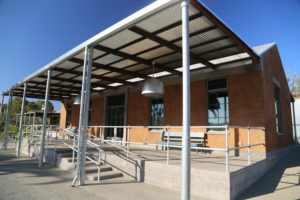
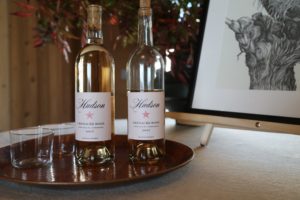
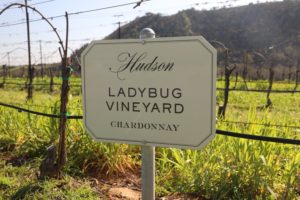 Hudson Vineyards is a 2,000 acre ranch (nearly 200 acres are planted to vines) contained entirely within the Napa side of Carneros in the southern part of Napa Valley, just north of the San Pablo Bay. Look for the Hudson flags flying near the entrance to their driveway off of Highway 12, including the black pirate jolly roger flag flying during harvest. From Highway 12, the private driveway to the winery winds through the property for about 3/4 of a mile. Founder, Robert Hudson (always referred to as Lee, which is his middle name) purchased the ranch in 1981 and soon thereafter started planting wine grapes. His first harvest was in 1983. A number of highly unusual varieties (for the Napa Valley) have been or are planted on the ranch including Aleatico, Albariño, Arneis, Friulano, Ribolla Gialla, Verdejo and Vermentino.
Hudson Vineyards is a 2,000 acre ranch (nearly 200 acres are planted to vines) contained entirely within the Napa side of Carneros in the southern part of Napa Valley, just north of the San Pablo Bay. Look for the Hudson flags flying near the entrance to their driveway off of Highway 12, including the black pirate jolly roger flag flying during harvest. From Highway 12, the private driveway to the winery winds through the property for about 3/4 of a mile. Founder, Robert Hudson (always referred to as Lee, which is his middle name) purchased the ranch in 1981 and soon thereafter started planting wine grapes. His first harvest was in 1983. A number of highly unusual varieties (for the Napa Valley) have been or are planted on the ranch including Aleatico, Albariño, Arneis, Friulano, Ribolla Gialla, Verdejo and Vermentino.
Over the years, Hudson Ranch has become one of the most famous sites in all of Carneros. Fruit from the Hudson Vineyards are sought after (especially the Chardonnay); simply look at the producers who source grapes from here including Aubert, Kongsgaard, Kistler, Cakebread, Failla, David Ramey and a variety of others. Those who purchase fruit from Lee are generally small family-owned producers who usually make a Hudson Vineyard designate wine and source from the same blocks each year.
The ranch is very historic from a viticulture point of view. One of the earliest vineyards was planted in Carneros in the late 1830s on what was the Huichica grant by a man named Jacov Leese, on the Sonoma County side of Carneros. For reference, George Yount planted the first ever vineyards in Napa County near Yountville during the winter of 1838/1839. Leese sold 1,200 acres to William Winter from Indiana who built the first winery in Carneros (Winter Winery).
The property was sold in 1881 to James Simonton. A deed listing in the October 7, 1881, issue of the Napa County Reporter lists a sale price as $40,000 for 1,115 acres. That same year the 57-year-old Simonton was to marry a 28-year-old woman, but unfortunately, he died the next year. During his career, he helped form the New York Daily Times (precursor to the New York Times) and was President of the Associated Press. While living in California became part owner of San Francisco based Evening Bulletin and Morning Call. The earliest records we can find of the property being called Talcoa Vineyard was in 1883; we have also seen references in the 1880s to this property as the Simonton Ranch.
In 1881, Missouri based viticulturist George (Johann Hermann Carl) Husmann, born in Germany in 1827 (died in 1902) and considered the father of the Missouri wine industry, moved to Napa Valley, met Simonton and was invited to oversee this property. This was not Husmann’s first time to California; in 1850 he came out lured by the excitement of California’s Gold Rush.
In the 1880s phylloxera was destroying vineyards in Europe; this part of Carneros was the site of the first successful American scientific experiments in which phylloxera-resistant rootstocks were developed. Husmann spent nearly 6 years managing the 2,000+ acre ranch and grew a number of varieties, a select few we have seen mentioned in various sources including: Marsanne, Malvasia, Mission and Sauvignon Vert (also called Tocai Friulano). And like today’s Hudson Ranch, grapes were not the only agricultural crop on the property. An article in the August 7, 1885, issue of the Napa Register mentions Husmann overseeing the shipment of 6 varieties of pears and 4 varieties of apples.
In 1883 while still living on the property Husmann wrote, “I do not fancy so called sweet wines or liquor wines such as angelica, port and sherry, and while they can no doubt also be made in Napa and Sonoma counties, and are made, I think that our climate and soil are especially adapted to furnish fine light wines, hocks, sauternes and clarets. These I believe, will yet furnish as fine a quality as any country, if the proper skill and care is applied to their manufacture, and we may as well leave the making of sweet wines to the southern portion of the state, where the climate is naturally adapted to them.”
Husmann also introduced the Concord Grape to Missouri in the mid 1850s and served as a delegate to the Missouri State Constitutional Convention where he signed in 1869 an ordinance abolishing slavery. Husmann wrote numerous journals and three books including American Grape-Growing and Winemaking in 1880 in which founder of To Kalon Vineyard, Hamilton Crabb authored a chapter on Napa Valley. The St. Helena Star notes that Husmann dropped off a copy to their office in January 1884. And for more reading, reference Author Tom Pinney’s chapter on Husmann in his book; The Makers of American Wine, A Record of Two Hundred Years.
One of his sons, George Charles Husmann also played an important role in Napa Valley’s viticultural history; the hallowed ground of To Kalon Vineyard in Oakville is where Husmann conducted a variety of grape experiments in the early 1900s, assisted by others including his brother Fred. George senior’s sons also owned a small cooper in Rutherford; a Napa Valley Register article dated December 1, 1893, references the Husmann Bros’ Cooper Shop and one special 32-stave miniature barrel made of walnut and maple holding, “some of Napa Valley’s choicest wine”. Husmann senior died in 1902 and is buried in Tulocay Cemetery in the city of Napa.
The property had several other owners in the 1880s including a W.D. Carlile. In 1888 the entire wine cellar and its contents were listed for sale. The following year Carlile sold the property (1,868 acres) to A.C. Farnsworth, a San Francisco based wholesale hardware merchant for an estimated $65,000. We have found no more references to using the name Talcoa Vineyard after 1892.
—
Lee (who we originally met with at the ranch) was born and raised in Houston, Texas. His father Edward Hudson founded Hudson Engineering Corporation in Houston in 1933 and spent much of life involved in oil and gas industries. He also oversaw a cattle operation (Hudson Cattle Company) and was involved in breeding and racing horses in Kentucy.
Lee’s mother, Cecil Blaffer “Titi” von Fürstenberg (died in 2006) was a significant patron of the arts in Houston. Through another marriage to an Austrian prince, she acquired her royal princess title. Her father, Lee’s grandfather Robert Lee Blaffer (reference the Blaffer Art Museum in Houston), was a founder of Humble Oil and later president of the company in the 1930s; this company’s influence was widespread – they built what would eventually become one of the largest refineries in the U.S. in Baytown, Texas and closer to Napa Valley, the company operated a refinery in Benecia for some time (with no traffic, about a 30-minute drive from Hudson Ranch). Humble Oil eventually became ExxonMobile. And another relative on Lee’s mother’s side of the family, William Thomas Campbell, founded what became Texaco.
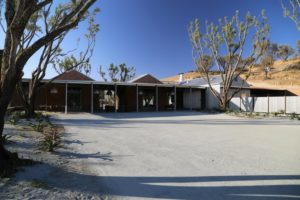
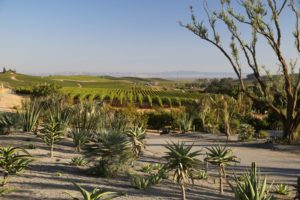 But Lee did not follow the path of family business. Rather, he majored in Horticulture at the University of Arizona and then later worked at Domaine Dujac in Bourgogne, France for 1.5 years, less than 10 years after this iconic winery was founded. Upon returning to the states, he earned his master’s degree in Viticulture and Enology at UC Davis. Interestingly enough, a several of his former classmates from Davis are now his clients or have been his clients including John Kongsgaard and Tony Soter. His efforts to produce premium wine grapes have been noticed over the years; in 2008 he was awarded “Grower of the Year” by the Napa Valley Grapegrowers. Today he and his wife Christina and son Ed help oversee the ranch operations.
But Lee did not follow the path of family business. Rather, he majored in Horticulture at the University of Arizona and then later worked at Domaine Dujac in Bourgogne, France for 1.5 years, less than 10 years after this iconic winery was founded. Upon returning to the states, he earned his master’s degree in Viticulture and Enology at UC Davis. Interestingly enough, a several of his former classmates from Davis are now his clients or have been his clients including John Kongsgaard and Tony Soter. His efforts to produce premium wine grapes have been noticed over the years; in 2008 he was awarded “Grower of the Year” by the Napa Valley Grapegrowers. Today he and his wife Christina and son Ed help oversee the ranch operations.
It wasn’t until 2004 however, that Hudson began producing their own wines which followed twenty years of producing home wines. Their current focus is on a limited number of wines (about 3,000 cases per year with the potential to grow this, perhaps up to 9,000 cases), including Chardonnay, Syrah and the “Pick Up Sticks Red”, a proprietary blend which includes Barbera, Grenache, Petite Sirah, Syrah and Viognier.
For many years their wine was produced offsite, at White Rock Vineyards, a small family-owned winery in the eastern hills above the Silverado Trail. However, on September 1, 2018, they opened a winery on site (including a sizable cave) and several buildings for hospitality; for many years this was the site of their pig pasture.
Christopher Vandendriessche is their winemaker; his family owns the small White Rock Vineyards located off of Soda Canyon Road. In the past, noted Napa winemaker John Kongsgaard provided consulting winemaking services.
Wines + Winemaking
Whites
The 2021 Hudson White Study California is a blend of 81% Sauvignon Blanc, 16% Chardonnay and 3% Semillon. This wine is medium yellow in the glass; the bouquet is a mix of both floral and fruit tones including honeysuckle citrus blossom, lime zest, white nectarine, red apple, honeydew melon and a hint of pineapple. As the wine evolves the aromatics open even more. This wine smells fresh, and reminded us of a spring day walking through flower lined residential streets of old town, Napa. It offers some mineralities on the palate along with flavors of white peach, lemon juice, lime, pomelo, green apple and pear. It shows plenty of citrus notes without being overtly citrusy if that makes any sense. There is a light sweetness that lingers on the very rich finish which reminded us a bit of tarragon or the sweetness one notices after eating stir fried chopped pieces of young artichoke hearts. This is a very balanced bottling.
Their Chardonnay program uses selections of the Wente clone sourced from the same blocks each year (small berries with very high phenolics). This is not your typical California Chardonnay. It is made in a Burgundian style and is barrel fermented using (non-inoculated) resident yeast. The fermentation is very slow often 12 to 18 months and undergoes full secondary fermentation. The wine is aged in mostly new French oak for up to 22 months. The wine is allowed to sit on the gross lees for a number of months before being racked. Several unique blocks are used to source this wine and each block is kept separate from each other during the entire aging including the free run and pressed juice. The separate lots are only combined during their final blending trials. Based on the time needed to craft this wine, it is usually released a year or two behind normal Chardonnay releases.
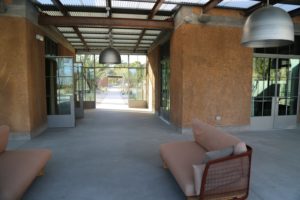
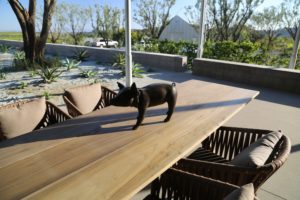
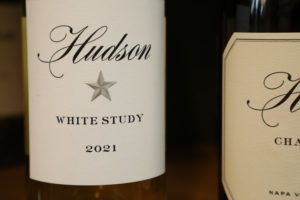 The 2016 Hudson Vineyards Chardonnay is golden yellow in the glass; it shows an intensity of fruit and spice which carries over onto the palate. This bottling offers aromas of honeysuckle, citrus, dried straw and cloves. A noticeable concentration of flavor and texture makes this an appealing wine to enjoy by itself. It is a balanced Chardonnay but with plenty of depth and layers. It feels rounded and almost oily or briny on the palate. A clean rich finish lingers for some time, featuring both fruit and spice.
The 2016 Hudson Vineyards Chardonnay is golden yellow in the glass; it shows an intensity of fruit and spice which carries over onto the palate. This bottling offers aromas of honeysuckle, citrus, dried straw and cloves. A noticeable concentration of flavor and texture makes this an appealing wine to enjoy by itself. It is a balanced Chardonnay but with plenty of depth and layers. It feels rounded and almost oily or briny on the palate. A clean rich finish lingers for some time, featuring both fruit and spice.
The 2007 Hudson Vineyards Chardonnay is a rich golden/amber in color. It has great phenolic grip which is very visible in the glass (great viscosity) and on the palate. You can feel this “grip” in your mouth; the wine has weight and character. However, it should be noted that this wine has excellent natural lively acidity and as a result helps balance its weight and structure. The palate shows notes of spice and is slightly creamy especially the mid palate. Rich expansive flavors include honey, red apple, toasted oak, and lingering notes of tangerine. The finish has just the right amount of tanginess to pair well with foods; this is a clean and balanced bottling.
Lee says, “the only additions we make to this wine are blood, sweat, tears and sulphur.” In terms of a high-quality wine, Lee told us, “For a great Chardonnay, you should close your eyes when tasting and have it taste like red wine.”
Reds
The 2020 Hudson Vineyards Grenache is medium ruby in color; the bouquet offers notes of strawberry, red cherries and dried herbs. The nose is initially a bit shy and needs some time to open. It’s flavor profile offers primarily red fruits rather than dark fruits and includes cherry, cherry cola, raspberry and a light fruit-roll up flavor – the kind of red colored candy you peel off of small plastic sheets. It’s textural feel are tannins which are light gravelly or sandy grained. The finish transitions from fruit, to a subtle but noticeable sweetness of anise/dark licorice followed a persistent dryness which outpaces the fruit.
The 2019 Hudson Vineyards Phoenix is a blend of 64% Merlot, 18% Cabernet Franc and 18% Cabernet Sauvignon. This wine is deep ruby in color; its initial aromatics are savory and earthy with some notes of old leather. It opens to some additional aromatics of pepper and cigar spices. And then transitions to fruit scents including of dark cherry, currant and some brambly characteristics. The palate reveals flavors of red cherry, red and dark plum, raspberry and dried herbs including sage. The tightly woven tannins linger with a dry and earthy feel; they are not heavy but they display a noticeable gravelly textured grip. One would not be wrong in calling this finish savory; it is built upon structure, fruit and acidity. This wine clearly has plenty of life ahead of it (we tasted 4 years post vintage).
The 2015 Hudson Vineyards Syrah is dark crimson in the glass; the bouquet is both savory and meaty with both a dark fruit and spice component. There is a lot going on in this wine aromatically including notes of cedar, dust, dark chocolate and black pepper. The palate reveals juicy mouthwatering fruit including flavors of blackberry. It has plenty of depth and is anchored by slightly dusty tannins that linger for quite some time.
Aleatico is a Black Muscat variety usually made as a red wine. Hudson Vineyards produces a highly unusual offering from this variety – a dry white wine.
Ranch Products
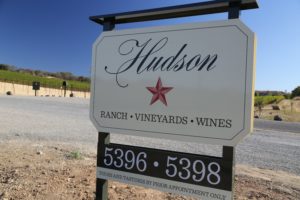
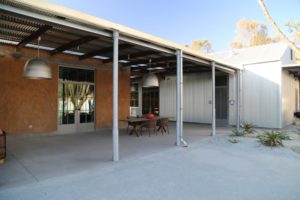 While certainly not a Texas sized ranch property, running a ranch of this size still takes a significant commitment from all involved. And a number of Hudson’s employees have been with the family for many years. The vineyards are separated into two primary sections – one towards the south of the property (that visitors drive through on their way to the winery) and one in the north. There are remarkable variations in microclimates within the property.
While certainly not a Texas sized ranch property, running a ranch of this size still takes a significant commitment from all involved. And a number of Hudson’s employees have been with the family for many years. The vineyards are separated into two primary sections – one towards the south of the property (that visitors drive through on their way to the winery) and one in the north. There are remarkable variations in microclimates within the property.
While wine grapes have been the focus of their operation since the beginning, the working ranch is extremely diverse. They provide fowl to the famed Alice Waters Chez Panisse restaurant in Berkeley, pork from their heritage pigs to the Fatted Calf in Napa, raise sheep, grow fruits and vegetables for a variety of outlets and local restaurants and also produce olive oil (approximately 1,000 olive trees grow on the ranch) and a limited production vinegar.
And certainly, an intriguing crop are the Atlantic Giant pumpkins grown each year by the ranch’s long time production manager, Leonardo Urena. He often grows some of the largest pumpkins in the state; the pedigree of these special behemoths is carefully tracked and cataloged. One pumpkin grown on site in the summer of 2009 took the top honors for largest pumpkin grown in the state of California at the annual Half Moon Bay Pumpkin contest. It weighed in at a whopping 1470 pounds!
These giant pumpkins have placed well in a number of related contests – and buyers have been known to have paid up to $5000 for a single seed from one of these ‘whoppers’. Less pricey seeds for this variety can be purchased from the Baker Heirloom Seed Co. Sometimes in the fall, one of Hudson Ranch’s smaller giant pumpkins will be on display in Napa’s Oxbow Public Market.
Hudson Greens and Goods
Hudson maintains a year-round produce market in the Oxbow Public Market in the city of Napa, offering a variety of seasonal fruits and vegetables, some of which are grown on the Hudson Ranch (including their tasty olive oil and vinegar) and delicious smoothies at the juice bar. Fresh cut flowers are also available as are a number of packaged products focusing on local vendors. Also note that some of their wine is also sold here and can also be tasted from the single automated wine dispenser available as a taste or a pour (about 1/2 a glass) in plastic go-vino cups.
Several options are offered for visitors to the ranch including the Collector Experience featuring a tour of the ranch followed by a seated tasting of their current release wines. The Connoisseur Experience focuses on their most limited production wines. And Hudson Ranch offers several tasting add-ons including an option to hike all or part of a 3-mile trail which meanders around the ranch or arrive early or stay following the tasting for a picnic lunch.
Hudson Wines are distributed in California, Texas and New York. Locally one can find the wines at Bouchon, Redd and Press restaurants and sometimes at select wine shops in Napa Valley.
The Hudson’s have been significant contributors to the Queen of the Valley Hospital in the city of Napa.
For more information about this working ranch, to purchase wines (some are only available to members), to join the Ranch Membership (wine club) or to schedule a tasting, visit: www.hudsonvineyards.com








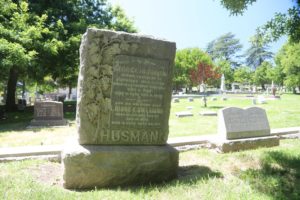
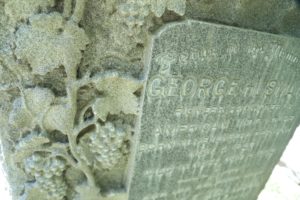
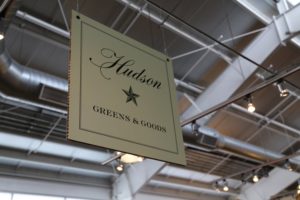
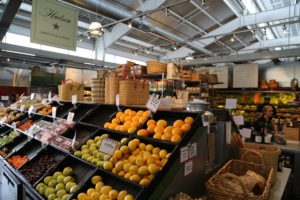
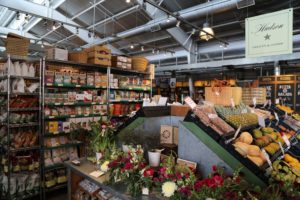
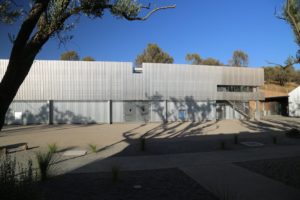
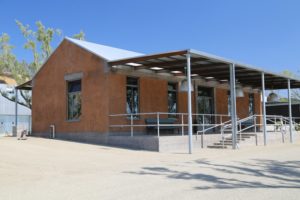
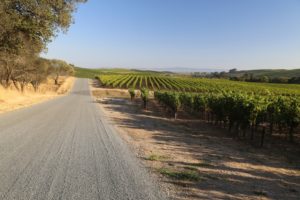
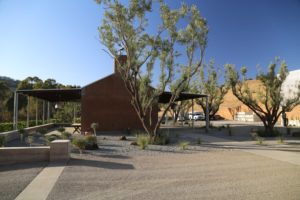
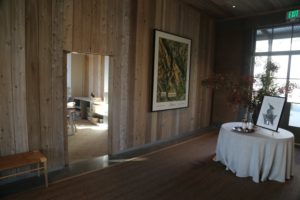
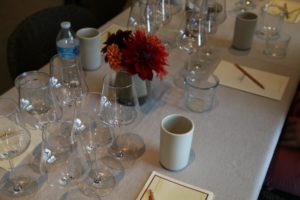
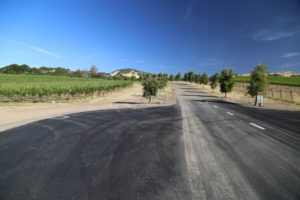
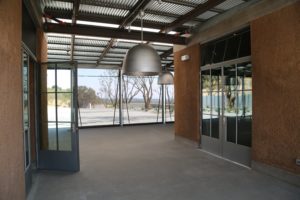
I received a basket of your White Wines this Christmas and I am extremely pleased with quality of the wine and all the DELIOUS treats!
I love the Pinot Grigio! Such a beautiful assortment of 4 wines and treats! I will forever order on my own and send as gifts!
Thanks to you and your staff for a great product!
Maria – thanks for stopping by and your nice comments. Glad to hear the Pinot Grigio was a hit 🙂
We wonder about your skull and crossbones flag. Is its timing related to Halloween?
They fly it when harvest is active.